Quick Tip: The Moon Salutation Sequence (Chandra Namaskar) is a calming yoga flow that prepares the body for restful sleep and balances energy by incorporating soothing, low-impact poses ideal for evening practice.
If you find yourself waking up groggy, fatigued, or just plain exhausted, a night time yoga routine could revolutionize your sleep cycles and energy levels. Experience the Yoga Moon Salutation, a sequence rooted in ancient traditions, to soothe your nervous system and ready yourself for profound, restorative sleep.
Anyone who has attended a Hatha or Vinyasa yoga class is likely familiar with the classic sun salutation sequence. While these flowing morning sequences draw on the energy and heat of the sun, yoga moon salutations aim to cool and calm the body with nighttime lunar energy.
Both flows have been practiced for over 2,500 years by yogis and meditators seeking a closer connection to themselves and the universe.
Here is everything you need to know about moon salutations and how to use them to improve your sleep, reduce anxiety, and calm your body.
What is a Moon Salutation in yoga?
A moon salutation (Chandra Namaskar) is an ancient yoga sequence designed to quiet the mind and calm the body while drawing on the feminine energy of the moon. It includes low-impact asanas that activate the parasympathetic nervous system (for rest and digestion) and open the hips. Moon salutations impart soothing and restorative yin energy that helps balance the fiery, warming yang energy of sun salutations.
Chandra Namaskar includes nine poses that are repeated in a cyclical manner. This standing sequence builds up to a Goddess Pose and then repeats each posture on the other side. The result is a cooling, stress-relieving, and hip-opening yoga experience that draws your mind inward for silence and peacefulness.
What is the difference between Sun Salutation and Moon Salutation?
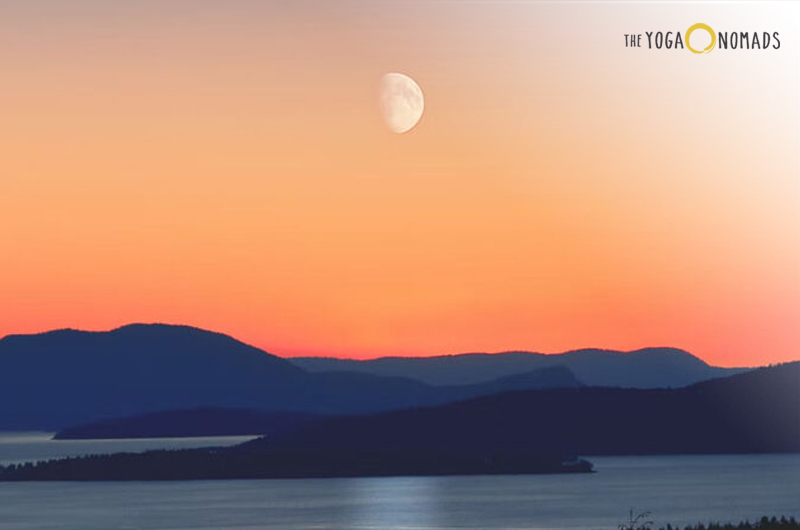

The yoga moon salutation sequence is the physical and energetic opposite of a sun salutation. While sun salutations (Surya Namaskar) are typically practiced in the morning to generate warmth and movement, moon salutations (Chandra Namaskar) are often practiced at the end of a yoga class or in the evening to help the body cool off and slow down.
The sun salutation is vigorous, energizing, and fast-moving. On the other hand, the yoga moon salutation is receptive, relaxing, and meditative. Traditional yogis used these mutually beneficial sequences to create a complimentary yoga practice for both morning and evening. Sun salutations are often a cardio workout while moon salutations don’t tend to elevate the heart rate.
In regards to actual poses, both sequences include familiar poses like Mountain Pose or Prayer Pose, Low Lunge, and Standing Half Moon. Yoga Moon Salutations have more hip openers like Goddess Pose and Side Lunge, while sun salutations have more “power poses” like Plank Pose and Chaturanga.
Both sequences are forms of Vinyasa flows that aim to sync movement with Pranayama breathing. Salutations typically coordinate upward movements with inhales and downward or deepening motions on exhales. They also both share a cyclical nature that begins and ends in Prayer Position (Pranamasana).
What are the benefits of Chandra Namaskar?
Whether you practice the moon salutation flow as part of your daily routine or as a cool-down to your studio practice a few times per week, this restorative sequence can have some profound benefits:
- Reduce stress
- Calm anxiety
- Relieve back pain and sciatic nerve pain
- Channel more creativity
- Balance yin (feminine) and yang (masculine) energies
- Stretch tight hip flexors
- Improve the quality of sleep
- Unwind from a long day
- Full body stretch
- Improve breathing
- Promote inner peace and meditation
Chandra Namaskar stretches and strengthens your spine, hamstrings, hip flexors, arms, and core while helping you quiet your mind from outside stressors. To reap the most benefits of yoga moon salutations, it’s best to practice at least once per day, ideally in the evening.
What is the Moon Salutation Sequence? 9 Simple Yoga Poses to Calm Down your Senses
The yoga moon salutation flow is a cyclical sequence. It moves through 9 different asanas (poses), building up to a central pose and then continuing back down to the first posture.
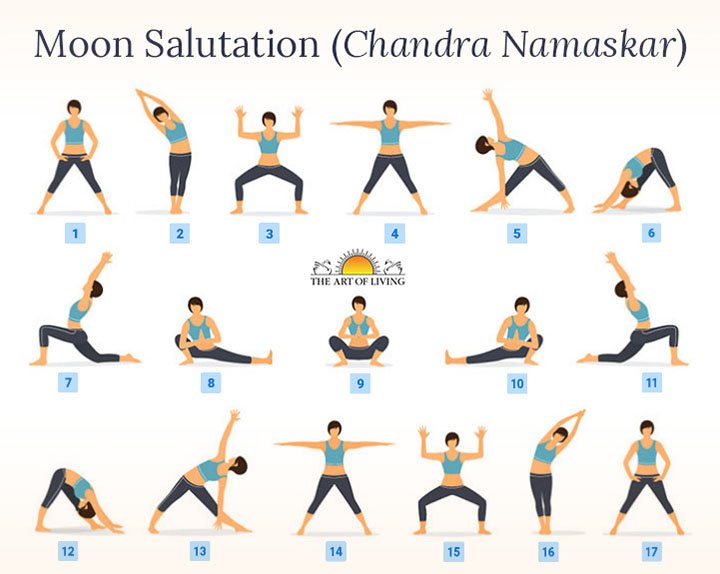

Standing Mountain Pose (Tadasana) or Prayer Pose (Paranamasana)
Begin in a standing position with your feet hip-width apart in the center of your mat. Keep your spine straight, and gaze forward. Bring your palms to a prayer position in front of your heart chakra and rest your thumbs on your sternum. Take a few rounds of inhales and exhales.
Standing Half Moon (Urdhva Hastasana)
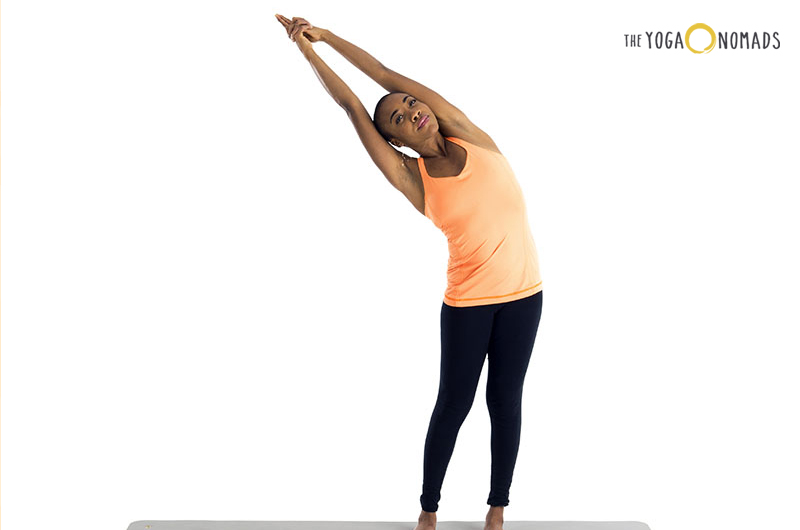

Inhale and bring your arms straight out to the sides and then overhead. Interlock your fingers and release the index fingers to point upwards. On an exhale, bend to the left and create an arched half-moon shape. Keep your glutes activated and feel an elongated stretch through the right side body.
On an inhale, come back to the center and then exhale to bend right. Be careful to keep your core engaged and avoid crunching into the side of the body.
Inhale back to the center and bring your palms down to the Namaste position.
Goddess Pose (Utkata Konasana)
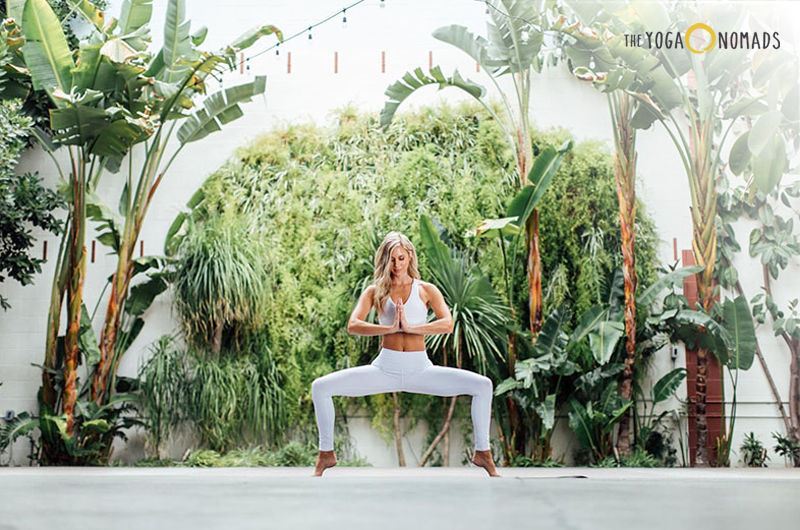

Inhale and step your left foot wide to the side of the mat. Turn both toes outward and exhale as you bend your knees to a right angle. Lower your hips into a squat, being sure that your knees don’t extend over your toes.
On an inhale, bring your arms straight out to your sides at shoulder height with palms facing forward. On an exhale, bend your elbows to a 90-degree angle and feel your shoulders slide down your back, opening the chest. Touch your forefingers and thumbs together in the Gyana mudra.
On each exhale, deepen your squat to feel a deeper stretch in the hips. Hold for a few breaths.
Goddess Pose is known to stimulate your root chakra and externally rotate your hips for deeper relaxation.
Five-Pointed Star Pose (Utthita Tadasana)
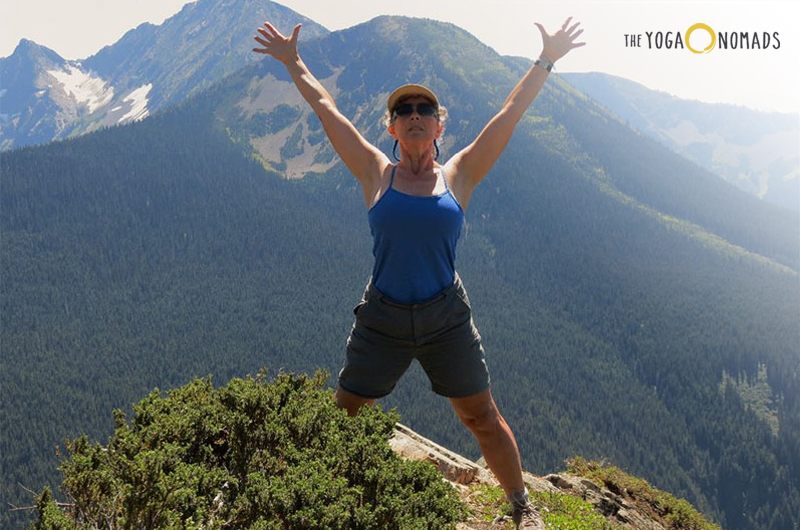

Inhale and push into the ground as you straighten your knees, keeping your feet wide apart. Straighten your arms once again at shoulder height with your palms facing upward and spread your fingers wide, feeling energy radiate outward through your fingertips. Hold for 3-5 breaths.
Triangle Pose (Trikonasana)
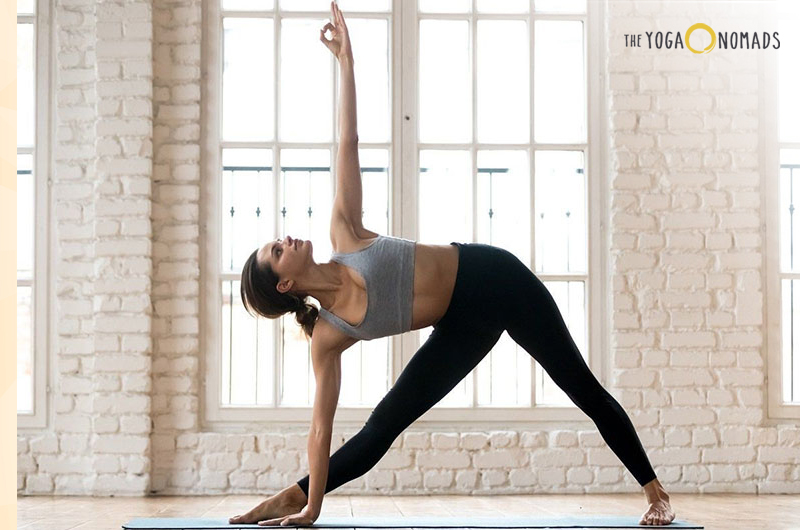

From Star Pose, inhale as you rotate your right foot out to the side to the top of the mat. Slightly rotate your back foot inward about 5-15 degrees. Adjust your stance wider as needed.
On an exhale, reach your right hand forward and shift your right hip backward. Then, hinge at the hip and rest your right hand on your shin or ankle, extending your left hand straight upward.
Try to keep your body in a perfect plane, with everything aligned as if there is a wall on each side. The hips should be aligned toward the side of your mat. Inhale and turn your gaze toward the sky as you engage your core, flex your legs, and hold for a few breaths.
Pyramid Pose (Parsvottanasana)
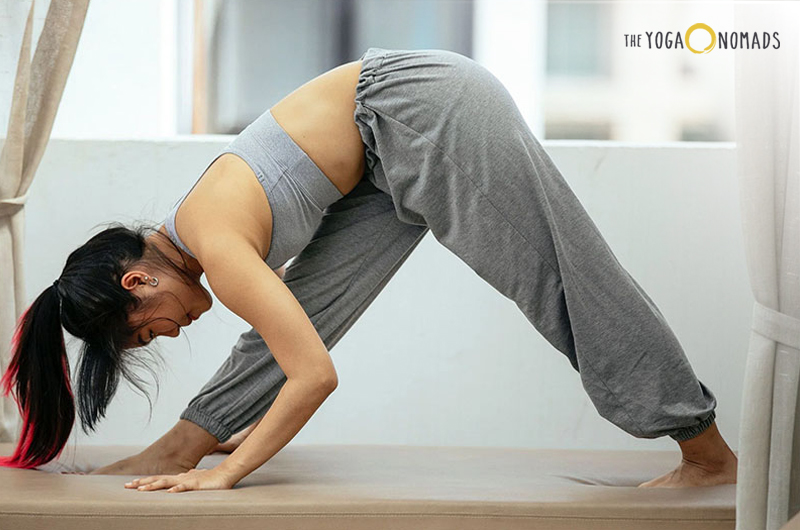

As you keep your right leg forward, take an inhale and bring your upper body back to an upright position with your hands above your head. Clasp the fingers together and, on an exhale, bend forward with your legs straight.
Fold over the right leg with your core engaged and rest your forehead as close to your right knee as possible. Rest your torso atop your thigh.
Try to keep your spine as straight as possible, releasing your hands to brace against the floor as needed. Hold for 3-5 breaths, focusing on slow, intentional inhales and exhales.
Low Crescent Lunge (Anjaneyasana)
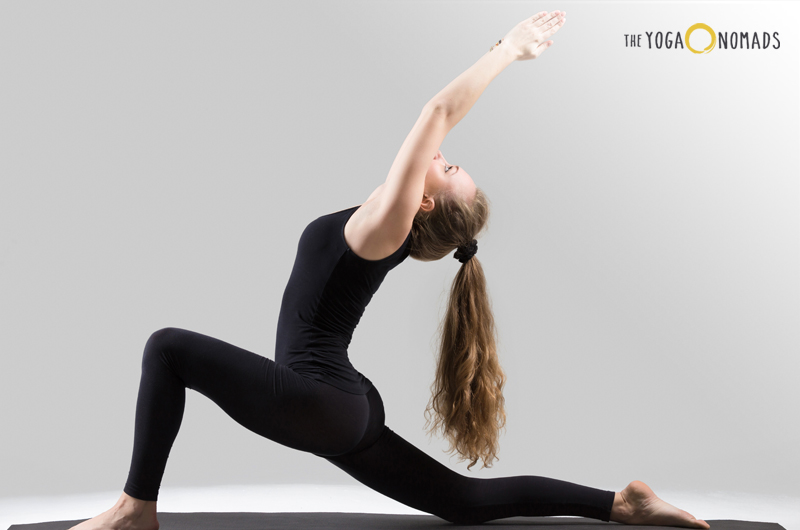

On an inhale, lift your arms up above your head and bend the right leg as you drop your left knee to the mat and squat down into a low lunge.
Allow the left leg to straighten behind you and let your left shin rest on the floor. Be sure that your right knee is aligned at a right angle above your ankle.
On each inhale, reach upward and back as if in a crescent moon backbend. On each exhale, sink the hips lower and feel a deep release of tension.
Low Side Lunge
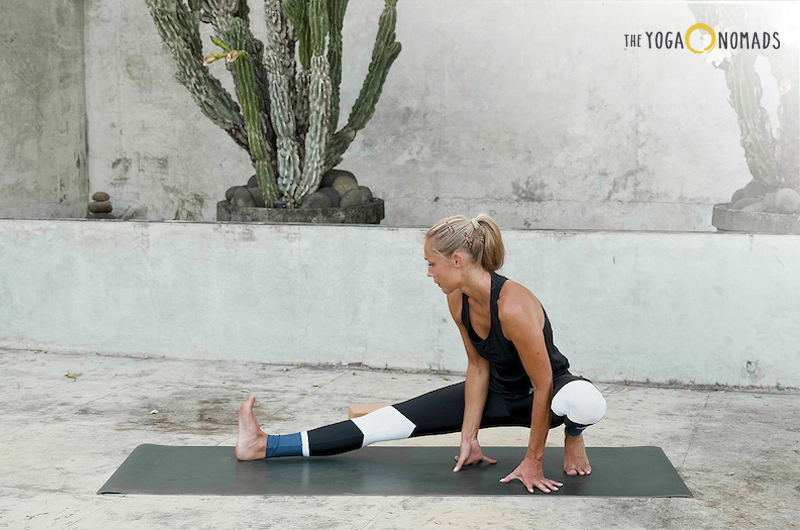

From your low lunge, rotate your left leg and torso to face forward along the long side of your mat. Exhale and extend your left leg outward to the left side while keeping your right knee bent. Keep your right toes forward and left toes pointing up as your tailbone reaches downward.
Once you’ve entered the low side lunge, bring your palms to the mat or the heart center. Ease out of the deep squat as necessary if it is too intense. Take 3-5 breaths as you feel your inner thigh and hip flexors opening.
Garland Pose (Malasana)
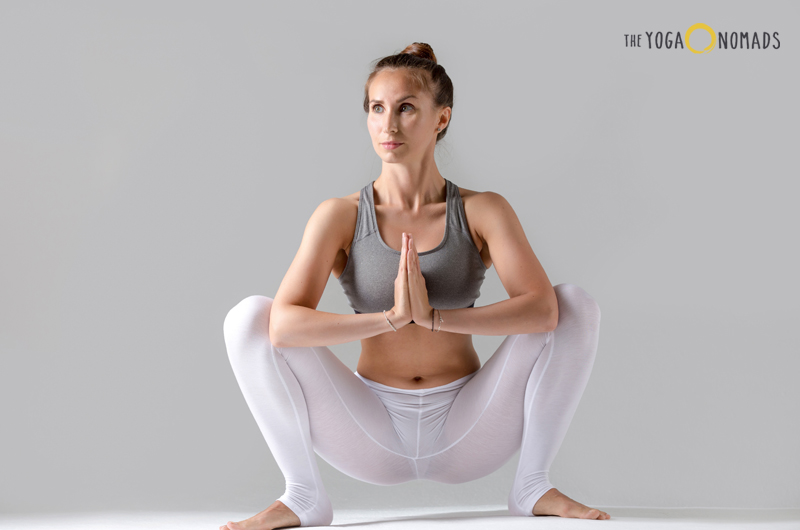

On an inhale, re-bend the left leg and bring both knees to face upward as you squat between your knees. Keep your heels rooted into the mat.
On an exhale, bring your palms to Namaste heart and enter as you press your elbows into your knees to further open your hips. Keep your spine as straight as possible as you feel your hips open even deeper and your pelvis reach toward the floor.
Malasana is known to channel your life force energy (qi or chi) down toward the root chakra. As it stretches the thighs and groin, remember to breathe very deeply for as many rounds as feels right. This pose can bring up some intense emotions, so try your best to keep your mind calm and focused.
This is the peak of the yoga moon salutation sequence. Now begins the cycle back through the poses on the other side.
Side Lunge (Left Side)
From Garland Pose, lean toward the bent left leg and straighten your right leg out to the side, keeping your hands at the heart center. Flex the right toes up toward the ceiling and breathe.
Low Lunge (Left Side)
Inhale and lift your arms overhead with the palms facing each other. Exhale and rotate your hips back to the front of your mat in a low lunge. This time, drop the right knee to the mat.
Inhale and reach up as you slightly backbend and open the heart to the sky. Be knowledgeable about bringing the left hip forward to maintain square-aligned hips.
Pyramid Pose (Left Side)
From Low Lunge, tuck your back toes and press into the right foot to straighten your right leg up off the ground. Inhale and straighten the left knee, then exhale and bend forward over the left thigh with your spine as straight as possible. Reach your arms to the floor and place your forehead as close to the left knee as possible.
Hold for 3-5 breaths, then inhale your torso back up.
Triangle Pose (Left Side)
On an inhale, pivot your torso so the side of the body is facing the front and your hips are aligned as if two walls are on each side. Bring your arms straight outward as your right hand reaches up and your left hand rests by the ankle or shin. Move your gaze upward and breathe.
Star Pose
From Triangle Pose, return to Star Pose by inhaling the whole body to standing. Pivot on your left heel to bring your left toes facing forward. Keep your feet wide and bring your arms straight up to the sides as if in the shape of a star.
Goddess Pose
On the next exhale, bend your elbows down into the “goalpost” position and pivot your toes out the sides with the heels inward. squat down once again into Goddess Pose, sitting deeper into your hips than before. Hold for 3-5 rounds of breath.
Standing Half Crescent Moon
On an exhale, push into the floor as you straighten your legs. Step the left foot back to meet the right foot and stand straight with your hands clasped up ahead, elbows touching your ears, and shoulders relaxed downward.
Inhale and bend to the left, feeling an arching stretch in the right side of the body. Exhale back to center, then slowly inhale to the right to round off your final half-moon pose.
Mountain Pose
Finally, return to Mountain Pose or Prayer Pose with your hands in the prayer position at the heart center. Close your eyes and take a few deep breaths as you thank yourself for showing up to the practice.
Envision yourself in a completely calm state of rest or sleep. Optionally, bow your head and say “Namaste” to end your practice.
When to Practice the Moon Salutation Sequence?
Unlike sun salutations, moon salutation sequences are not a cardiovascular-intensive exercise. They should not be practiced in a vigorous or fast motion.
Instead, move slowly and with the intention for a soothing experience. Yoga Moon Salutations are far better for times of relaxation such as after a long work day or right before bed.
Yoga Moon Salutation is best practiced:
- As a “cool down” at the end of a yoga practice or workout
- To unwind after a stressful event or workday
- For women, during their moon cycle
- Before a meditation practice
- In the evening, about 30 minutes before bed
Incorporating Moon Salutations Yoga Practice into Your Nightly Routine
Many of us have established evening habits that help us unwind after a day. Have you ever thought about incorporating yoga moon salutations into your regimen?
This sequence is more, than a series of movements; it serves as a pathway to tranquility. When the stars begin to twinkle I take it as my signal to roll out my yoga mat. I lower the lights. Sometimes light a candle to create an atmosphere.
I start with breaths to release the day’s tension. Each posture in the moon salutation brings me closer to calmness. I hold each position for a bit longer relishing the stretch and the quietude. It’s not about being flawless; it’s about being present.
By the time I arrive at the pose, my body feels lighter. My mind is clearer. Nights, when I practice yoga moon salutations, tend to result in sleep for me. It’s like a soothing melody, for my spirit.
If you’re seeking a way to relax before bedtime give this tradition a try—it may just become your favorite part of the evening.
Is Moon Salutation Good for Sleep?
Moon Salutation is a soothing sequence in hatha yoga that can be beneficial for promoting better sleep. To start, stand at the top of your mat and extend your arms overhead, raising your eyes to the sky to honor the full moon. Although sun and moon salutation sequences both have their unique benefits, practicing moon salutations before bed can help prepare your mind and body for a restful night’s sleep. There are 3 ways you can include moon salutations in your practice – as a standalone sequence, as part of a longer class, or even in a restorative yoga session focused on relaxation.
The calming quality of the poses in moon salutations can be especially helpful for those who struggle with insomnia or anxiety. If you are already familiar with sun salutations, adding moon salutations to your practice can provide a complementary way to wind down at the end of the day. Consider following along to a YouTube video or attending a class that incorporates yoga nidra techniques to enhance the restorative benefits of the sequence. The next full moon is the perfect time to give it a try and see how it impacts your sleep patterns.
A moon salutation draws on the soothing feminine, lunar energy of the evening, which makes this sequence ideal for aiding in a good night’s rest. Many yoga practitioners use moon salutation to create energy of calmness and relaxation right before bed. The key is to breathe as deeply as possible and move slowly.
Delving into How the Phases of the Moon Influence Your Yoga Routine
Have you thought about how the different phases of the moon could impact your yoga sessions? The various stages of the moon can have an effect, on our moods and energy levels. This is why some yoga enthusiasts customize their routines to sync up with these cycles.
For example, when there’s a moon our energy tends to be heightened. It’s a time for joy and appreciation. On the side, a new moon signifies a period for reflection and setting intentions. Incorporating moon salutations during these times can deepen our connection with the energies.
I’ve personally noticed that practicing Chandra Namaskar (Moon Salutation) during the waxing moon phase readies both my body and mind for growth.
It feels like I’m embracing opportunities. Conversely when it’s a waning moon following the sequence aids me in letting go and releasing akin to how the moon sheds its light.
This approach to yoga goes beyond poses; it involves aligning oneself with nature’s rhythms. It encompasses an approach that respects the flow of life in the cosmos. While it may sound unconventional, to some there are accounts attesting to how the moon influences human emotions and spirituality.
When you lay down your yoga mat next take a moment to think about the phase of the moon. It could add a perspective, to your routine.
The Importance of Moon Salutations, a Calming Sequence in Maintaining Hormonal Equilibrium
Understanding the Balance of Hormones
Maintaining a harmonious hormonal balance is essential for overall health and wellness. Hormones influence various aspects of our well-being, including mood, energy levels, sleep quality, and metabolism. Imbalances in hormones can result in issues such as sleep disturbances, feelings of unease, and persistent tiredness. Moon salutations, known for their soothing and rejuvenating effects, can play a significant role in fostering hormonal equilibrium.
The Impact of Moon Salutations on Hormones
Moon salutations trigger the parasympathetic nervous system, which is responsible for promoting relaxation and aiding digestion. Activation of this system helps decrease cortisol levels—the hormone associated with stress. Elevated cortisol levels can disrupt sleep patterns and contribute to feelings of anxiety. By reducing cortisol production, moon salutations facilitate a state of tranquility and serenity.
Specific Yoga Poses and Their Hormonal Benefits
Certain yoga poses within the Moon Salutation series offer specific advantages for hormonal balance. For instance, Goddess Pose stimulates the root chakra—a vital energy center linked to reproductive well-being. This stimulation may assist in regulating menstrual cycles and alleviating premenstrual symptoms. Additionally, poses like Garland Pose incorporates deep hip opening movements that release tension commonly stored in the hips—an area often affected by emotional stress.
Personal Testimony on Achieving Hormonal Equilibrium
I have observed notable enhancements in my hormonal health through my yoga practice of incorporating moon salutations into my routine. Previously grappling with irregular menstrual cycles and mood fluctuations,
After practicing regularly for a few weeks, I noticed that my menstrual cycles became more predictable and I felt more emotionally stable. The soothing flow of the sequence aided me in handling stress better, subsequently bringing a sense of equilibrium to my hormone levels.
Moon salutations go beyond just physical advantages. They serve as a potent method for attaining hormonal harmony. By stimulating the parasympathetic nervous system and focusing on specific energy centers, this series can assist in regulating hormones and enhancing overall health. If you’re facing hormonal fluctuations, incorporating moon salutations into your nightly routine could be beneficial.
Pop quiz! 🧘🤔
Moon salutations are typically practiced in the morning to generate warmth and movement.
The yoga moon salutation sequence includes a pose called Goddess Pose, which is known for opening the hips and stimulating the root chakra.
Practicing yoga moon salutations can help improve the quality of sleep and reduce anxiety.
Thanks for your feedback!


